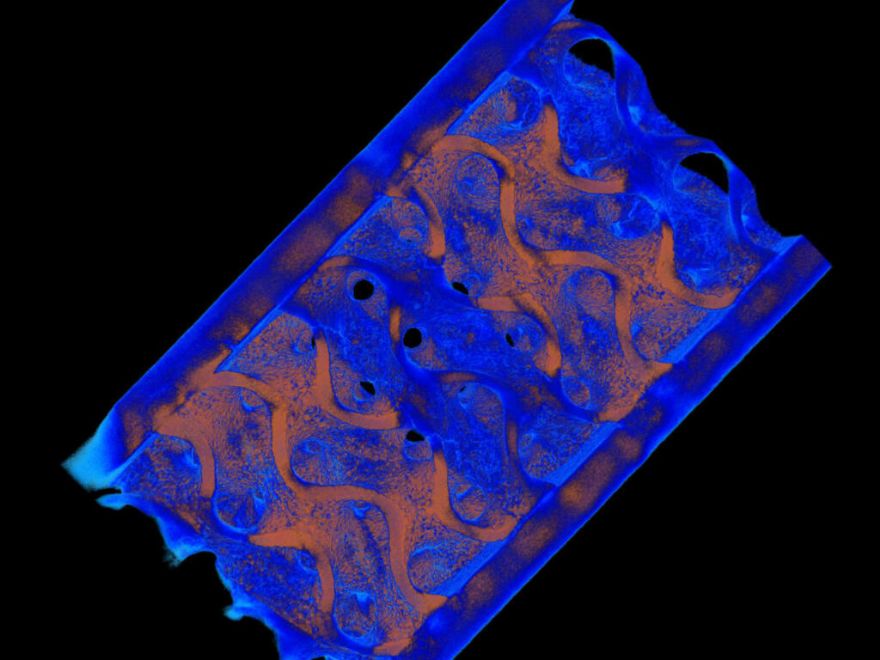 A micro-CT volume rendering of the multi-material gyroid beam, fabricated from low-carbon stainless steel, seen in blue, and bronze, seen in orange, using the Aerosint selective powder deposition system. Picture courtesy of the SHAPE Lab, CIMP-3D and the Penn State Center for Quantitative Imaging
A micro-CT volume rendering of the multi-material gyroid beam, fabricated from low-carbon stainless steel, seen in blue, and bronze, seen in orange, using the Aerosint selective powder deposition system. Picture courtesy of the SHAPE Lab, CIMP-3D and the Penn State Center for Quantitative ImagingA team of researchers from Penn State (the Pennsylvania State University, in the USA) have used a new 3-D printing method to fuse two metals together into a single structure and produce a complex metal build that was once only possible with welding. They used an additive manufacturing (AM) process known as multi-material laser powder bed fusion — enabled by a newly acquired system in Penn State’s ‘Centre for Innovative Materials Processing Through Direct Digital Deposition’ (CIMP-3D) — to print a complex structure out of a blend of low-carbon stainless steel and bronze (90% copper and 10% tin). The researchers published their approach in the journal
npj Advanced Manufacturing.
Jacklyn Griffis, a doctoral candidate in mechanical engineering and first author of the paper, said: “In a process called selective powder deposition, we can now melt multiple powdered metals in a single layer during the AM process — and we were the first university in the USA to do so. The fine powders are tens of microns in diameter, almost like flour. We can selectively deposit the powder with micron-level resolution, then melt it together with a laser.”
Researchers used an Aerosint selective powder deposition system, which CIMP-3D acquired in August 2023, to 3-D print and test the metal part. The system was integrated into an existing 3D Systems ProX320 AM machine in the Systems for Hybrid-Additive Process Engineering (SHAPE) Lab at CIMP-3D. Jacklyn Griffis said a 1cm-tall metal part includes thousands of layers of metal powder and takes a few hours to print.
3-D printing multi-material metal componentsGuha Manogharan, the corresponding author, associate professor of mechanical engineering, head of the SHAPE Lab, and co-director of CIMP-3D, added: “We now have the processing technology to 3-D print these multi-material metal components, as well as a way to monitor the melt pool and observe and address potential issues in real time. To do this, we produce a digital 3-D rendering of the part through CT scans, which we use to look for pores, cracks at the interface or micron-scale defects.”
In 3-D printing two metals in a single powder simultaneously, researchers had to work through complex questions on processing conditions and part quality. In this paper, they focused on analysing the build orientation of the part to understand what would change if the part was 3-D printed upright, flat or on its side.
Jacklyn Griffis concluded: “In our analysis, we connected the part’s build orientation to a number of observations about the structure, including defects like cracking and porosity, interfacial microstructures, and the ways elements are diffused or blended across the interface. We then connected those printed defects to the part’s performance, producing a complex shape known as a gyroid, which is used in applications such as heat exchangers and biomedical implants. We chose the gyroid shape to demonstrate the capabilities of the new manufacturing process — only multi-material laser powder bed fusion can create a multi-material gyroid shape.”